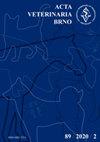Effect of sperm and glycerol concentration on epididymal sperm motility parameters after thawing
IF 0.7
4区 农林科学
Q3 VETERINARY SCIENCES
引用次数: 0
Abstract
The aim of this study was to evaluate the effect of different glycerol concentrations and different sperm concentrations on stallion epididymal sperm motility indicators after thawing. For statistical analysis, 25 stallions were used. Collection of the epidydimal spermatozoa was performed as a retrograde flush of cauda epididymis and ductus deferens within 12 h post castration. After evaluation, the resuspended spermatozoa were centrifuged, the supernatant removed and the spermatozoa resuspended in Gent semen extender to get three different groups with different concentrations of sperm (250 × 106 in ml, 500 × 106 in ml, 1000 × 106 in ml) and different final glycerol concentrations (2%, 4%, and 6%). Therefore, 9 different samples were finally obtained from each stallion. The spermatozoa were packed and placed in a fridge (4 °C) for 2 h, then placed in liquid nitrogen vapour (−80 to −100 °C) and after 25 min plunged into the liquid nitrogen and stored at −196 °C for at least 5 days. The selected straws were individually thawed in a 38 °C water bath for 30 s prior to post-freezing analysis. Motility indicators were assessed at 0, 60, 120, and 180 min after thawing. Parametric test was used for analysis; the measured indicators were total motility, progressive motility, curvilinear velocity, straightness, and average-path velocity. In this study, the best results were reached in samples diluted into a concentration of 1,000 × 106 in ml, regardless of the concentrations of glycerol.精子及甘油浓度对解冻后附睾精子运动参数的影响
本研究旨在探讨不同甘油浓度和不同精子浓度对解冻后种马附睾精子活力指标的影响。为了进行统计分析,使用了25匹公马。在去势后12小时内,对附睾尾部和输精管进行逆行冲洗,收集附睾精子。评价后,将重悬的精子离心,取上清,在根特精液扩增器中重悬,得到不同浓度的精子(250 × 106 ml、500 × 106 ml、1000 × 106 ml)和不同终甘油浓度(2%、4%、6%)的三组。因此,每匹马最终获得9个不同的样本。将精子包装在冰箱(4℃)中保存2 h,然后置于液氮蒸气(- 80 ~ - 100℃)中,25 min后放入液氮中,在- 196℃保存至少5天。在冷冻后分析之前,将选定的吸管在38°C水浴中单独解冻30 s。分别于解冻后0、60、120和180 min评估运动指标。采用参数检验进行分析;测量的指标是总运动、渐进运动、曲线速度、直线度和平均路径速度。在本研究中,无论甘油浓度如何,当样品稀释到1000 × 106 ml浓度时,均可获得最佳结果。
本文章由计算机程序翻译,如有差异,请以英文原文为准。
求助全文
约1分钟内获得全文
求助全文
来源期刊

Acta Veterinaria Brno
农林科学-兽医学
CiteScore
1.00
自引率
33.30%
发文量
36
审稿时长
18-36 weeks
期刊介绍:
ACTA VETERINARIA BRNO is a scientific journal of the University of Veterinary and Pharmaceutical Sciences in Brno, Czech Republic.
The scientific journal Acta Veterinaria Brno is dedicated to the publication of original research findings and clinical observations in veterinary and biomedical sciences. Original scientific research articles reporting new and substantial contribution to veterinary science and original methods that have not been submitted for publication elsewhere are considered for publication. A written statement to this effect should accompany the manuscript, along with approval for publication by the author´s head of department. The authors bear full responsibility for the contents of their contribution. Book reviews are published, too.
 求助内容:
求助内容: 应助结果提醒方式:
应助结果提醒方式:


